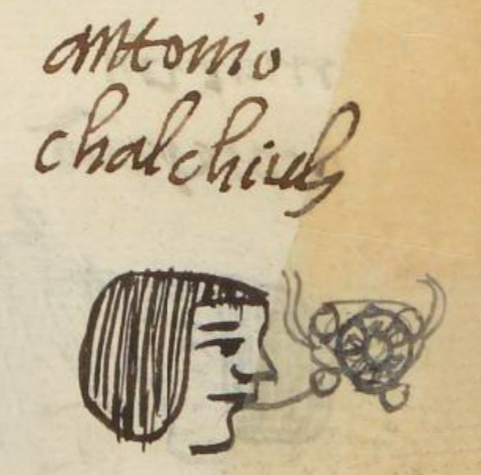Chalchiuh (MH505r)
This black-line drawing of the simplex glyph for the personal name Chalchiuh shows a stylized version of a chalchihuitl) green stone in a frontal view, looking something like a circular flower with a center and petals all around the center. The outer circle also has four smaller circles spaced fairly evenly around the perimeter. There may be additional parts to this green stone in a lighter-colored ink at the back, of there may be a different glyph that was drawn first and then painted over. The shape at the back is something like a horizontal cylinder with smoke coming out of each end. It has no obvious phonetic or iconographic contribution.
Stephanie Wood
The examples of the chalchihuitl glyph from the Codex Mendoza (below) show the brilliant coloring of green, red, and white, and more intricate detail. But there is a clear iconographic echo. A plainer chalchihuitl from the Matrícula de Huexotzinco, one that more clearly shows the circular shapes, is found on folio 491 recto (below).
It should not be a surprise to see a child (in this case it was a boy) named Chalchiuh, given that parents often referred to their babies as precious green stones. Being called Jade might be compared to names known today in English-speaking places, such as Jewel, Ruby, Pearl, or Diamond.
See the article (on the left) about shimmer in glyphs. This might help explain the small circles on the outer ring of the glyph.
Stephanie Wood
antonio
chalchiuh
Antonio Chalchiuh
Stephanie Wood
1560
Jeff Haskett-Wood
jades, green stones, chalchihuites

chalchihui(tl), a precious green stone, https://nahuatl.wired-humanities.org/content/chalchihuitl
Chalchihuite
Stephanie Wood
Matrícula de Huexotzinco, folio 505r, World Digital Library, https://www.loc.gov/resource/gdcwdl.wdl_15282/?sp=89&st=image
This manuscript is hosted by the Library of Congress and the World Digital Library; used here with the Creative Commons, “Attribution-NonCommercial-ShareAlike 3.0 License” (CC-BY-NC-SAq 3.0).






